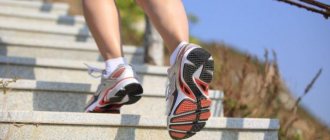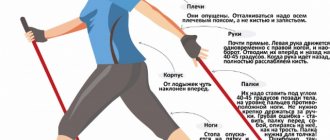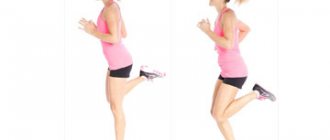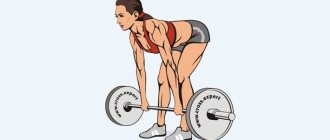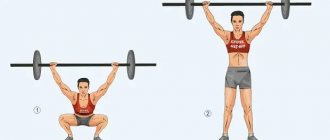Stair running is popular among runners and trail runners when there are no running routes with elevation gain nearby. In urban environments, it is easy to find stairs for training even in the fresh air, not to mention in high-rise buildings. On the stairs they prepare for trails, skyrunning, mountain marathons, and vertical races. Stairs are also useful for road runners to develop leg strength. We have collected in this article the most useful information about training on stairs, the correct technique and exercises.
The benefits and harms of running up the stairs
Running up stairs is a heavy, high-intensity exercise and is therefore contraindicated for beginners. To run up the stairs, you need to have at least a little experience of regular training (from six months) and a cardiovascular system prepared for stress. For beginners, we recommend walking up the stairs and monitoring your heart rate so as not to overload your body.
Source: kinopoisk.ru
Benefits of running on stairs
- Develops leg strength: the thigh muscles, calf muscles, buttocks, core muscles, joint stabilizers are loaded
- Improves running efficiency - the body begins to spend fewer resources at the same speed
- Develops speed and strength qualities
- Raises the threshold of anaerobic metabolism (TANO)
- Develops maximum oxygen consumption (VO2)
The dangers of running up stairs
Running up stairs can be harmful if you violate the principle of gradualness and immediately start training from scratch. Before exercising on stairs, consult a specialist if you have any health problems.
- Phlebeurysm
- A lot of excess weight
- There are problems with the spine and joints
- Problems with the heart and blood vessels
Running up stairs for weight loss
Running up stairs is very energy-consuming, so many people use this method to lose weight. It is promoted by many fitness trainers and running resources on the Internet. Yes, running stairs burns a lot of calories, but using it to lose weight is a big mistake that can cost you your health. The stairs are too high a load for an unprepared person, so start taking care of yourself with proper nutrition, short walks/jogs and strength exercises. Nutrition and a small calorie deficit should come first, and physical activity is only an auxiliary component.
Source: verticalworldcircuit.com
Steps to calories calculator. Calorie consumption when walking: table and calculator
Race walking, like simple walks, is an excellent method of losing weight. With such physical activity, the body quickly burns calories. Fat deposits disappear evenly, the body acquires a beautiful relief. If you want to add muscle load and increase kcal consumption when walking, you can attach special weights to your legs.
Benefits of walking
Burning calories while walking is easily regulated by changing the pace, speed, step length, periodically switching to running, adding additional exercises (leg swings, walking with sticks, etc.). The body is not overloaded from such activities. Endurance increases, heart function improves, blood vessels are strengthened.
Calorie loss when walking is stable, easily calculated using special formulas, and predictable. Advantages over other physical activity options:
- Running puts stress on the spine and legs. Running is contraindicated for people with diseases of the musculoskeletal system, heart, and blood vessels.
- Swimming requires additional training and the purchase of a pool membership.
- Cycling is only suitable for those who have access to equipment. In addition, this sport is not recommended for people with bad knees.
What determines calorie consumption when walking?
Energy consumption directly depends on height, weight, person, type of terrain and speed of movement. Calorie consumption for a simple walk for 1 hour without additional exercise can be found in the table:
The data is averaged, but the consumption will be individual for each person. The following factors influence energy costs:
- Weight. A fat person has to spend more energy on movement. The thinner you are, the less effective the exercise will be. To avoid losing results, adjust your diet.
- Age. Over time, the rate of metabolic processes decreases. The effectiveness of physical activity also decreases.
- Type of walking. With a simple walking step, a person loses a minimal amount of calories. The most effective and energetic type is Nordic walking, which also uses the arms, shoulder girdle and back, increasing calorie consumption by 40-50%.
- Traffic intensity. This factor equally includes speed and type of terrain. The more difficult it is to move, the more calories will be burned. Climbing uphill will greatly increase energy costs.
- Class time. You should walk for at least 1 hour. During the first 20-25 minutes, the muscles only warm up and only then begin to expend energy with maximum efficiency.
Calculation of energy consumption when walking
To fully plan your workouts, you should learn to calculate energy costs for walking. The number of calories consumed depends on the following indicators:
- distance traveled;
- weight;
- movement speed;
- number of steps;
- step length.
Depending on the person's weight
Knowing the mass of a person, the distance traveled and the angle of inclination of the terrain, you can calculate the calories burned. Energy consumption is calculated using the formula:
Coefficient x distance (km) x person's weight (kg) = number of calories (kcal)
The coefficient depends on the inclination of the surface. Its value is determined by the formula 0.5+0.09*T, where “T” is the slope of the terrain in degrees. So, when walking 2 km uphill with a slope of 4°, a person weighing 90 kg will spend:
(0.5+0.09*4)*2*90=154.8 kcal
Calorie calculation by number of steps
Step length is the distance between the points of initial contact (the place where the supporting leg steps) of the legs when walking. You can calculate it using a pedometer:
- Start the pedometer.
- Walk 100 meters.
- Divide 100 by the number of steps taken.
The average stride length of a normal-sized adult is:
- 79 cm for men;
- 66 cm for women.
Using a pedometer and knowing the length of your step, you can calculate the number of calories burned while walking. The calculation is carried out according to the formula:
A person with a stride length of 0.81 m, weighing 75 kg, walking 8700 steps uphill with a slope of 6°, will spend:
((0.5+0.09*6)*0.81*8700*75)/1000=549.6 kcal.
Walking on stairs: technique and features
It is better to start exercising on the steps by walking.
This will help prepare the body for stress and reduce the risk of injury. Walk up the stairs, stepping on each step or stepping over one at a time. Descend slowly, alternating direct and side descents - this way the load on your joints will be less. The technique for walking up the steps is simple: keep your body straight with a slight lean forward. Bend your arms at the elbow, move them with each step as if you were walking fast. Place your foot halfway, without resting on your heels. Movements must be continuous and continuous. After practicing this step on each step, try stepping on one after another. In this exercise, the technique is completely different: with each step, extend your hip and strain the front of your thigh, while keeping your foot relaxed. As you step over the step, fix your extended hip, taking short pauses.
After some time of walking up the steps, the body adapts: the pulse will not rise sharply, shortness of breath will go away, and the muscles will stop hurting after the workout. This means you can move on to running up the stairs.
Which shoes to choose?
Shoes with shock-absorbing soles are best for running on raised surfaces. Such shoes protect joints well from the shock load that occurs when running, and in our case the load will be even higher.
Avoid sneakers and other shoes with thin soles; for running up stairs you should use sneakers. The main criteria for sneakers in this case will be:
- Lightweight (within 500 grams). The lighter the shoe, the better;
- The toe should bend easily;
- It is advisable that the sole be made of filayte or phylon.
Lace up your sneakers as tightly as possible - and go ahead to conquer the peaks. And this time literally!
Stair running: training and technique
Warm up for at least 10 minutes before training. The warm-up includes light running, light stretching and general development exercises.
The essence of the training: up - run, down - at a calm pace. Start with 30-second lifts and declines, and gradually increase the duration of the lift and the number of repetitions.
Each step can be run at a low pace or with a high frequency of movements. To increase the load, run over a step. Descend straight or half-sideways, alternating methods to reduce stress on your joints. Don't forget that running downhill also loads your muscles and helps prepare you for running downhill.
Increase the pace and duration of your workouts gradually. For the first time, training for 10-15 minutes at a walk or at a low pace is enough. Gradually increase the total training time to 25-30 minutes. When the workout becomes easy, pick up the pace and increase the number of repetitions. Monitor your pulse - this is an important indicator of the general condition of the body.
Follow the technique: keep your body straight with a slight lean forward. Straighten your shoulders, do not lift them up. Bend your elbows and actively move them as if running, raise your hip when walking. Place your foot halfway up the step so that your heel does not touch the surface.
After your workout, cool down for at least 10 minutes: light jogging, thorough stretching, massage or foot rolls.
Nutrition for cardio training for weight loss
Cardio training is represented in many sports: cycling, swimming, jumping rope, brisk walking, aerobics, dancing, etc. Diet is an integral procedure that determines the effectiveness of exercise. If the exercises do not involve burning excess fat and body weight is within normal limits, then the diet does not involve serious restrictions. In this case, a normal healthy diet with a slight restriction of animal fats and light carbohydrates is sufficient.
Note! Cardio exercise awakens your appetite, and if you do not follow the diet, you can gain excess weight.
The diet during cardio training should include:
- animal proteins (beef, chicken breast, milk, fish) in a ratio of 60–70% of the daily diet;
- carbohydrates (cereals, cereals, vegetables, fruits) 20% of the daily value;
- vegetable fat (nuts, vegetable oil) at least 30 grams per day.
Important information! Reducing the number of calories (by more than 20%) during cardio exercise can lead to muscle tissue degeneration.
Cardio training on a jump rope
Nutrition after cardio training to burn fat
To achieve the desired result, you must follow proper nutrition before and after training. The main principle of nutrition is:
- carbohydrates - before training;
- proteins - after training.
You cannot exercise on an empty stomach, but you should eat food 1.5–2 hours before training.
Nutrition after exercise is important. Eating is allowed after half an hour.
Option 1:
- complex carbohydrates - 60%;
- protein - 40%.
Option 2:
- fast protein (whey protein, egg white);
- an hour later - protein, complex carbohydrates, fats (40x40x20).
Sources of calories
Stair running competition: vertical races
Stair running is not only a training tool, but also a whole series of starts around the world. The first vertical race took place in 1977 at the Empire State Building in New York. Now vertical races are combined into entire world series Vertical World Circuit and Towerrunning World Association . Starts are held in the tallest skyscrapers in the world: Milan, Paris, New York, London, Beijing, Shanghai, Dubai, Osaka, Hong Kong.
Similar races are held in some Russian cities:
- Race to the Vysotsky skyscraper in Yekaterinburg
- Race along the Chkalov Stairs in Nizhny Novgorod
- “High Height Race” in a business center in Perm
Play sports, move and travel! If you find a mistake or want to discuss the article, write in the comments. We are always happy to communicate.
Subscribe to us on Telegram , YandexZen and Vkontakte
